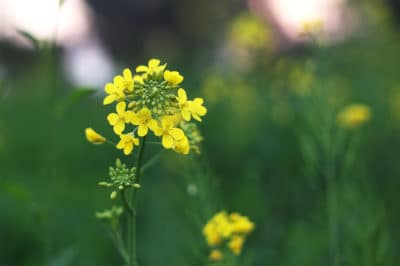Description
Flowers in the mustard family are all similar, and they’re a great way to identify a member of the mustard family. Once you identify a mustard then you know it is edible. Most commonly flowers yellow but occasionally white and about 1 inch in diameter. They appear in button-like clusters and have four petals and six stamens, four long and two short. Stamens are the male portion of the flower, which is self-fertile, and they look like tendrils poking out of the flower center.
The four petals form a cross, and this is where the name cruciferous comes from when we refer to vegetables in the Brassicaceae family. Mustards are biennial, so they will flower during their second year of growth. Flowers will appear as the season begins to warm in mid-spring. Here is a checklist for mustard flower identification:
- Yellow or White
- Four Petals
- Four long stamens
- Two short stamens
- Stames form a “H” shape
- Growing in clusters
History
Because mustards one of the earliest plants to be cultivated and found wild all over the world their history is extensive. Romans added mustard flowers raw to their wines and vinegar to give them an extra flavor. They also frequently added them to love potions believing them to have aphrodisiac qualities.
Native to just about the entire ancient world, exactly when mustard was brought to the Americans is unclear. Early settlers brought it as a food source and allowed it to naturalize throughout North American ecosystems.
One historic story from Napa Valley tells of missionaries that would scatter the mustard seeds along trails between missions. When the winter ended and the mustards bloomed they could trace their way back to each other.
Unfortunately, there aren’t any natural predators of mustard on the continent, and it has the ability to suppress the growth of other native species. It takes over and becomes a dominant understory plant. Today it is considered a noxious and invasive weed in North America.
Cultivation
Mustard plants have been cultivated for thousands of years. All parts of the plant are edible and useful from the root to the flower and seed. Because it is often harvested in its first year for the leaves, the flowers can be somewhat elusive. When allowed to bloom, mustard plants produce beautiful stalks bursting with edible flowers.
Mustard flowers are delicious raw or boiled. They make a gourmet addition to salads and soups. Use them in just about any recipe calling for edible flowers, their spiciness blends better with savory dishes. Store them fresh in a sealed container in the fridge until they show signs of wilt.
